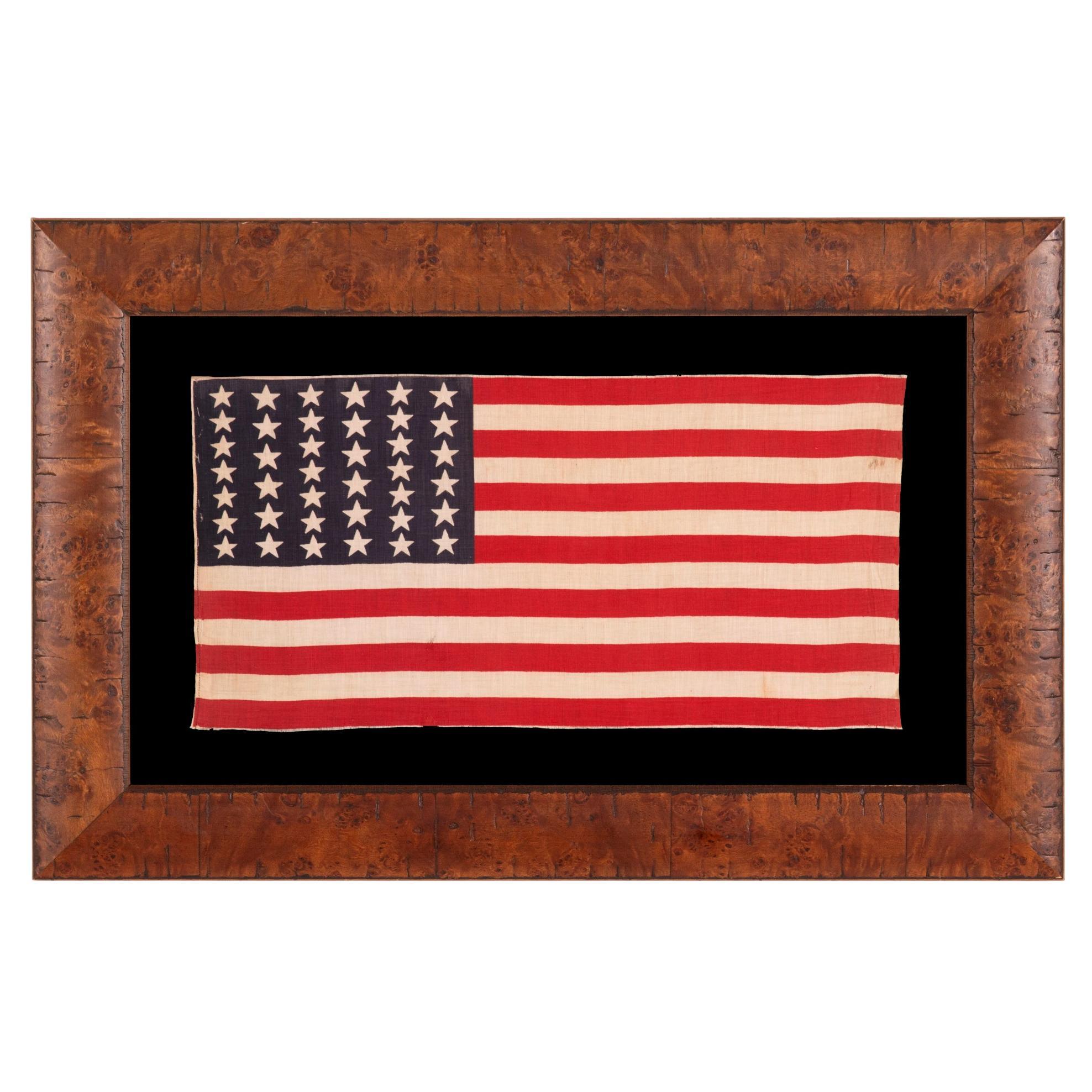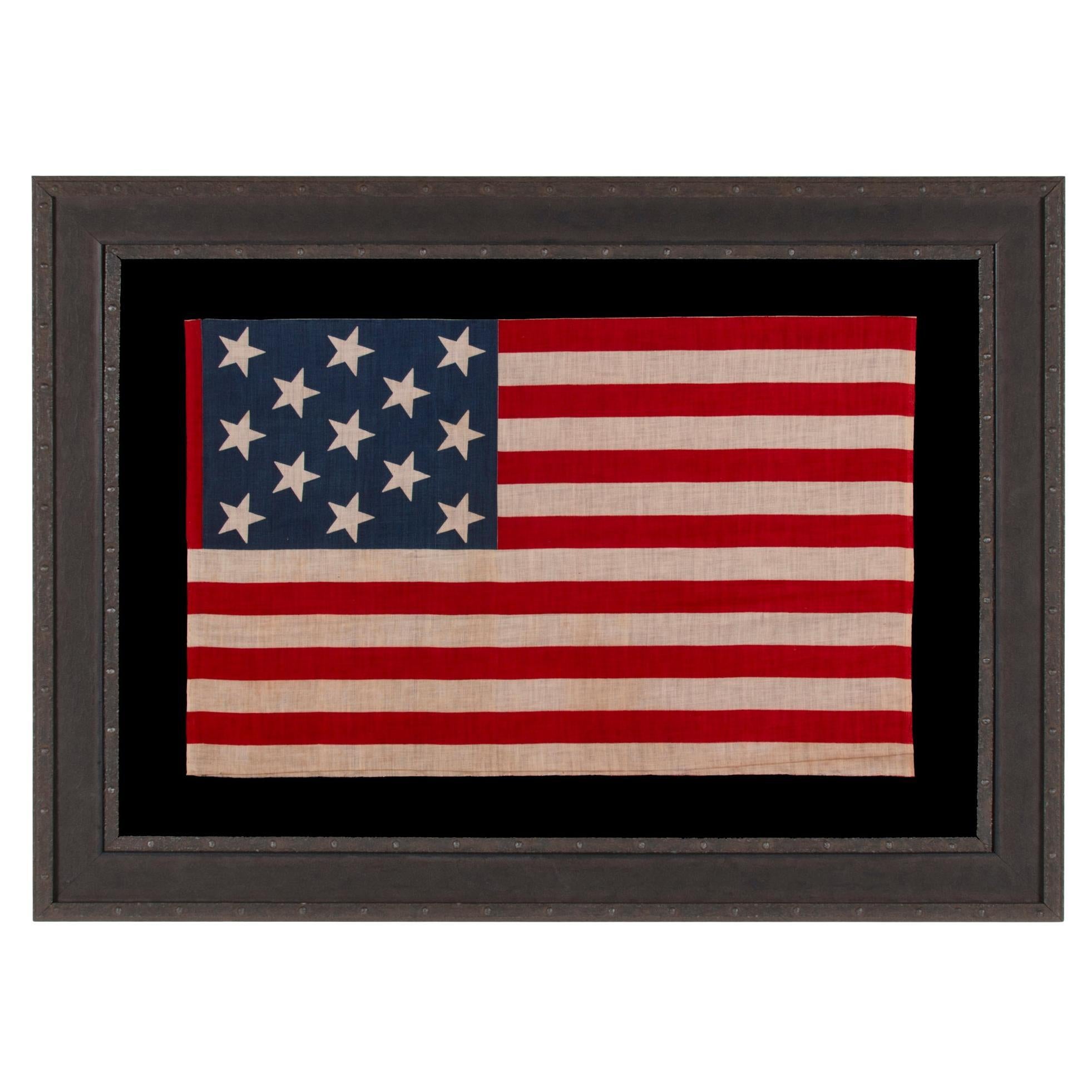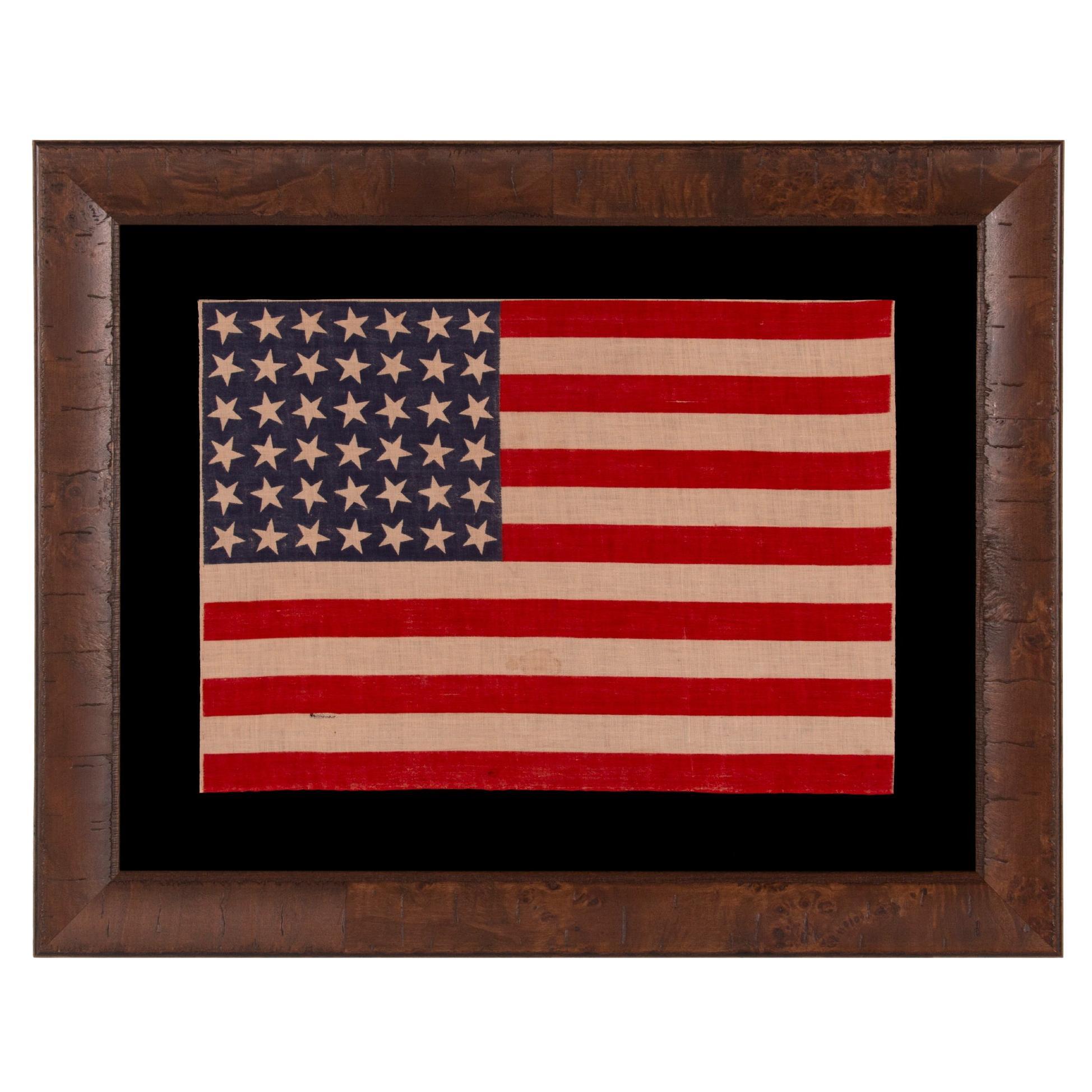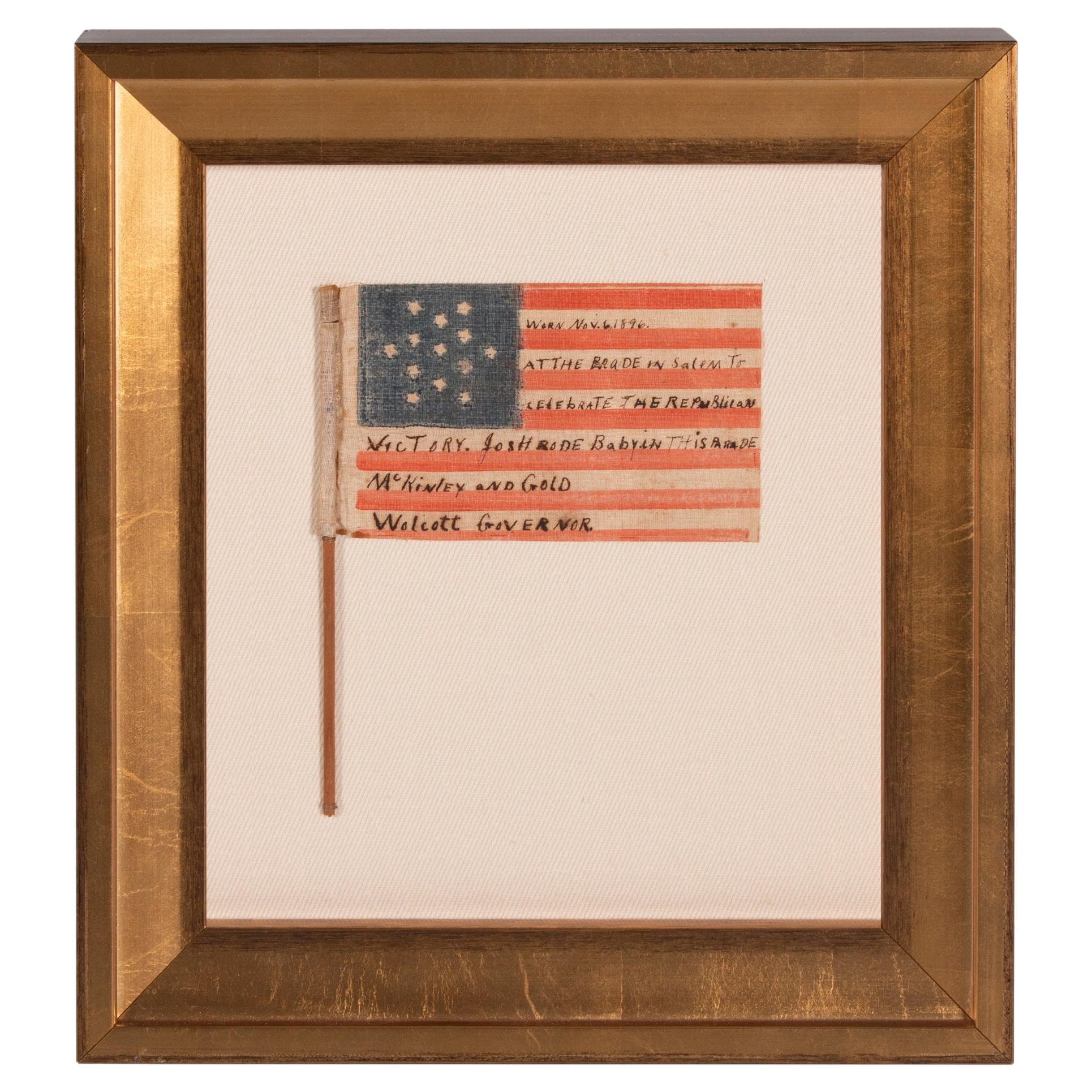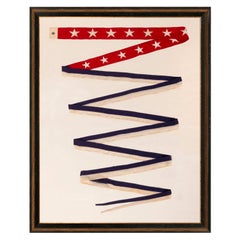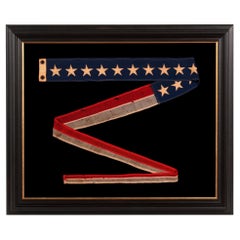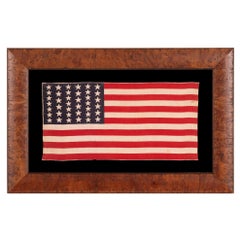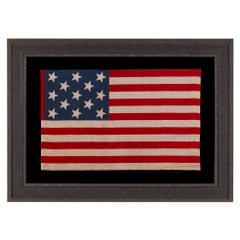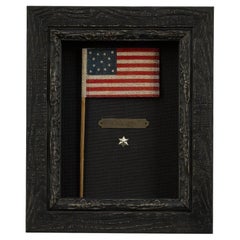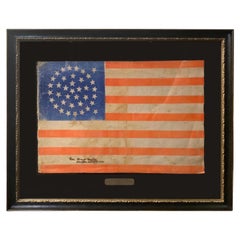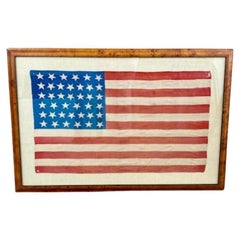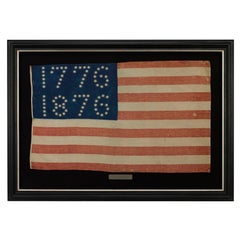Items Similar to Stars & Stripe Pennant from the March on Washington, August 28, 1963
Want more images or videos?
Request additional images or videos from the seller
1 of 8
Stars & Stripe Pennant from the March on Washington, August 28, 1963
Price Upon Request
Price Upon Request
Price Upon Request
Price Upon Request
Price Upon Request
Price Upon Request
Price Upon Request
Price Upon Request
Price Upon Request
Price Upon Request
About the Item
BOLDLY GRAPHIC AND UNUSUAL STARS & STRIPES PENNANT FROM THE ‘MARCH ON WASHINGTON’ OF AUGUST 28TH, 1963, WHEN MARTIN LUTHER KING DELIVERED HIS HISTORIC "I HAVE A DREAM" SPEECH; THIS EXAMPLE EXHIBITED AT THE REGINALD F. LEWIS MUSEUM OF MARYLAND AFRICAN AMERICAN HISTORY:
Stars & Stripes flags, banners, and pennants, made during the 19th century, were sometimes adorned with interesting graphics and textual messages. This continued into the beginning of the 20th century but dwindled quickly during the first quarter. After this time, it is very unusual to find interesting adaptations of the American national flag, printed with patriotic and political messages, especially with aesthetics that seem to hail from the previous century.
This fantastic and rare political pennant was flown in tribute of what would soon be touted as one of the most galvanizing events in American civil rights history. It would have been raised and waved by an attendee on that landmark day, in August of 1963, in our nation's capital, when Martin Luther King, Jr. delivered his "I Have a Dream" speech.
Printed on paper, the triangular design is comprised of a vertical blue bar, on which 43 stars surround the words that served as the mantra of the 1960's black rights movement: "We Shall Overcome". Joan Baez sung the folk song of the same name that day at the parade, written by Pete Seeger and others, to the crowd in attendance estimated between 200,000 and 300,000.
The star count has no specific meaning. The stars simply serve to decorate the text and complete the flag-like image. The blue bar is followed by a field of 17 stripes—again with their number merely decorative—on which the following words appear in the same blue ink:
"I Marched for Equality in the Freedom Parade; August 28, 1963; Washington, D. C."
The official title for the assembly was "The March on Washington for Jobs and Freedom." Two blue stars follow in the last white stripe, for unknown purpose, possibly once again for artistic balance.
Today just a tiny handful of examples are known, in addition to this one. I acquired and sold three others, now in private collections. This exact pennant was lent by Jeff R. Bridgman Antiques, Inc. to the Reginald F. Lewis Museum for Maryland African American History and Culture for an exhibit entitled "For Whom it Stands: The Flag and the American People," from May 17, 2014 – February 28, 2015. It is illustrated twice in a book by the same name, authored by Michelle Joan Wilkerson (2015, Reginald F. Lewis Museum for Maryland African American History and Culture), p. 22 and 61.
One of the others, in a private collection in Washington, D.C., was carried by a woman by the name of Theresa Gehring, recollected in a story that she dictated to her son, documenting the day's events. Another is among the holdings of the Smithsonian.
I also acquired a period photograph of one of these pennants in use on August 27th, 1963, affixed to an automobile antenna. The photo was taken by United Press International (UPI), during preparations for the event. At least two other images also survive of these pennants, being displayed by attendees of the march, on the same day.
Provenance: (see above for exhibition history) Mounting: The solid walnut frame retains its original varnished surface and dates to the Civil War era. This is a pressure mount between 100% cotton velvet and U.V. protective plexiglass.
Condition: The pennant was formerly framed, probably by the original owner, and it was folded at the top and bottom. There is pigment loss at the creases. Two punched holes allowed a wooden dowel to be inserted, which is an unusual method of affixing a staff. There are minor tears around the holes. The extreme tip at the fly end is slightly torn. There is minor soiling throughout. Because paper parade flags and pennants rarely survived, the state of preservation is expected and perfectly acceptable. Further, the extreme rarity warrants practically any condition.
- Dimensions:Height: 18.75 in (47.63 cm)Width: 24.75 in (62.87 cm)Depth: 3 in (7.62 cm)
- Materials and Techniques:
- Place of Origin:
- Period:
- Date of Manufacture:1963
- Condition:See Item Description.
- Seller Location:York County, PA
- Reference Number:Seller: pat-2511stDibs: LU849744272432
About the Seller
5.0
Recognized Seller
These prestigious sellers are industry leaders and represent the highest echelon for item quality and design.
Established in 1991
1stDibs seller since 2008
70 sales on 1stDibs
Typical response time: 9 hours
- ShippingRetrieving quote...Shipping from: York County, PA
- Return Policy
Authenticity Guarantee
In the unlikely event there’s an issue with an item’s authenticity, contact us within 1 year for a full refund. DetailsMoney-Back Guarantee
If your item is not as described, is damaged in transit, or does not arrive, contact us within 7 days for a full refund. Details24-Hour Cancellation
You have a 24-hour grace period in which to reconsider your purchase, with no questions asked.Vetted Professional Sellers
Our world-class sellers must adhere to strict standards for service and quality, maintaining the integrity of our listings.Price-Match Guarantee
If you find that a seller listed the same item for a lower price elsewhere, we’ll match it.Trusted Global Delivery
Our best-in-class carrier network provides specialized shipping options worldwide, including custom delivery.More From This Seller
View AllU.S War Department Commissioning Pennant with 13 Stars
Located in York County, PA
EXTREMELY RARE U.S. WAR DEPARTMENT COMMISSIONING PENNANT WITH 13 STARS, A REVERSAL OF THE U.S. NAVY COLOR SCHEME, TWENTY-FOUR FEET ON THE FLY, SP...
Category
20th Century American Political and Patriotic Memorabilia
Materials
Wool
Price Upon Request
Commission Pennant with 13 Stars, like for Private Vessel, Ca 1892-1910
Located in York County, PA
Commission pennants are the distinguishing mark of a commissioned U.S. Navy ship. Flown at the topmast, the typical American format is a long blue field, usually with a single row of white stars, although sometimes with their total divided into two rows, followed by two long stripes, red-over-white. A ship became commissioned when this pennant was hoisted. Flown during both times of peace and war, the only time the pennant is not flown is if a flag officer or civilian official was aboard and replaced it with their own flag.
Sometimes the owners of private ships mimicked the use of Navy signals. Some seafaring men would have served in the Navy and become privy to various practices in that capacity. Others flew them purely for stylistic reasons, either on a regular basis or while the boat was dressed for special occasion. Hudson River steamers regularly flew pennants of this nature, as evidenced by period photography as well as the paintings of artists such as John and James Bard...
Category
Antique Late 19th Century American Political and Patriotic Memorabilia
Materials
Wool
Price Upon Request
39 Star Antique American Parade Flag with Stars in Two Sizes, Ca 1876
Located in York County, PA
39 STARS IN TWO SIZES, ALTERNATING FROM ONE COLUMN TO THE NEXT, ON AN ANTIQUE AMERICAN PARADE FLAG WITH AN UNUSUALLY ELONGATED PROFILE, DATING TO THE 1876 CENTENNIAL, NEVER AN OFFICI...
Category
Antique 1870s American Political and Patriotic Memorabilia
Materials
Cotton
13 Star Antique American Parade Flag, ca 1876-1899
Located in York County, PA
13 STAR ANTIQUE AMERICAN PARADE FLAG, WITH A 3-2-3-2-3 CONFIGURATION OF STARS, AN EXTREMELY SCARCE AND UNUSUALLY LARGE VARIETY, MADE circa 1876-1899
13 star American national parade...
Category
Antique Late 19th Century Canadian Political and Patriotic Memorabilia
Materials
Cotton
Price Upon Request
42 Star Parade Flag with Scattered Stars, ca 1889-1890
Located in York County, PA
42 STARS ON AN ANTIQUE AMERICAN FLAG WITH SCATTERED STAR POSITIONING, REFLECTS THE ADDITION OF WASHINGTON STATE, MONTANA, AND THE DAKOTAS, NEVER AN OFFICIAL STAR COUNT, circa 1889-18...
Category
Antique Late 19th Century American Political and Patriotic Memorabilia
Materials
Cotton
13 Star Antique Parade Flag, Hand Inscribed by the Owner in Salem, MA 1896
Located in York County, PA
ANTIQUE AMERICAN FLAG WITH 13 STARS ARRANGED IN 6-POINTED GREAT STAR / STAR OF DAVID PATTERN, OF A TYPE MADE FOR THE 1876 CENTENNIAL OF AMERICAN INDEPENDENCE, WORN AND HAND-INSCRIBED...
Category
Antique 1870s American Political and Patriotic Memorabilia
Materials
Cotton
You May Also Like
13-Star Flag Waver for the Centennial Celebration
Located in Colorado Springs, CO
This small charming 13-star flag waver was made for and sold during the nation’s Centennial celebration in Philadelphia in 1876. All manner of flags were made for the official Centen...
Category
Antique 1870s American Federal Political and Patriotic Memorabilia
Materials
Fabric
38-Star American Parade Flag, Flown at a Reception for President Grant, 1880
Located in Colorado Springs, CO
This is a beautifully colored 38-star American parade flag, flown at a public reception for Ulysses S. Grant in October of 1880. This printed flag features a rare, triple medallion s...
Category
Antique 1880s American Political and Patriotic Memorabilia
Materials
Cotton
19th Century American 39 Star Flag, circa 1889
Located in Nantucket, MA
19th Century American 39 Star Flag, circa 1889, a period printed silk parade flag with a wavy pattern of dancing stars. This was never an official flag of the United States but was m...
Category
Antique 1880s American Federal Political and Patriotic Memorabilia
Materials
Silk
Centennial Celebration "1776-1876" American Flag Banner
Located in Colorado Springs, CO
Presented is a rare Centennial patriotic flag banner, dating to 1876. The flag’s brilliant blue canton is spectacular, with 81 five-pointed, rayed stars, arranged to read “1776” and “1876.” The flag’s design is completed with thirteen alternating red and white stripes. The flag is a three-piece, treadle-sewn sewn construction, printed on a thin wool and cotton blend. Along the edge, there is a narrow, treadle-sewn sleeve made of cotton tape.
In the lead up to the nation’s Centennial in 1876, flag makers and individuals looked to the past for designs to produce as part of the country’s many celebrations. Popular interpretation of the stars and stripes undoubtedly reached its climax of variety and originality at the time of our Nation’s first Centennial. Since no design restrictions were placed on flagmaker’s imaginations and no strict distinctions were drawn between official and unofficial star counts, it is no surprise that, on the occasion of the Centennial, creativity in flag design was not the exception, but the rule.
The cantons from this period presented an array of geometric abstractions. Great star patterns, referred to as the “starry flower of Liberty” by Oliver Wendell Holmes, that were popular from 1818 and on, resurfaced in Centennial flags...
Category
Antique 1870s American Political and Patriotic Memorabilia
Materials
Wool, Cotton
48-Star Printed American Flag, Commemorating Arizona Statehood, 1912-1958
Located in Colorado Springs, CO
This is an original 48-star American parade flag, celebrating Arizona statehood. A wonderful product of our nation's early history, this flag is an authentic antique, with a fly date...
Category
Mid-20th Century American Political and Patriotic Memorabilia
Materials
Fabric
42-Star 7th Cavalry Regiment Parade Guidon, Printed "7A", Circa 1889-1890
Located in Colorado Springs, CO
Presented is 42-star 7th Cavalry Regiment parade guidon, dating to 1889-1890. The guidon is printed in cotton, and stenciled over with a “7” over crossed swords of the 7th Cavalry Re...
Category
Antique 1880s American Political and Patriotic Memorabilia
Materials
Cotton
More Ways To Browse
Hole Punch
Vintage American Memorabilia
Stars And Stripes Vintage
Pennant Frame
Vintage Stars And Stripes Flag
Vintage Flag Stand
African Flag
Teddy Roosevelt
Navy Flags
Antique British Flag
British Union Jack
Used Flag Poles
48 Star Flag
Centennial Furniture
Framed American Flag Art
1889 Flag
13 Star Flag
Civil War Antiques


